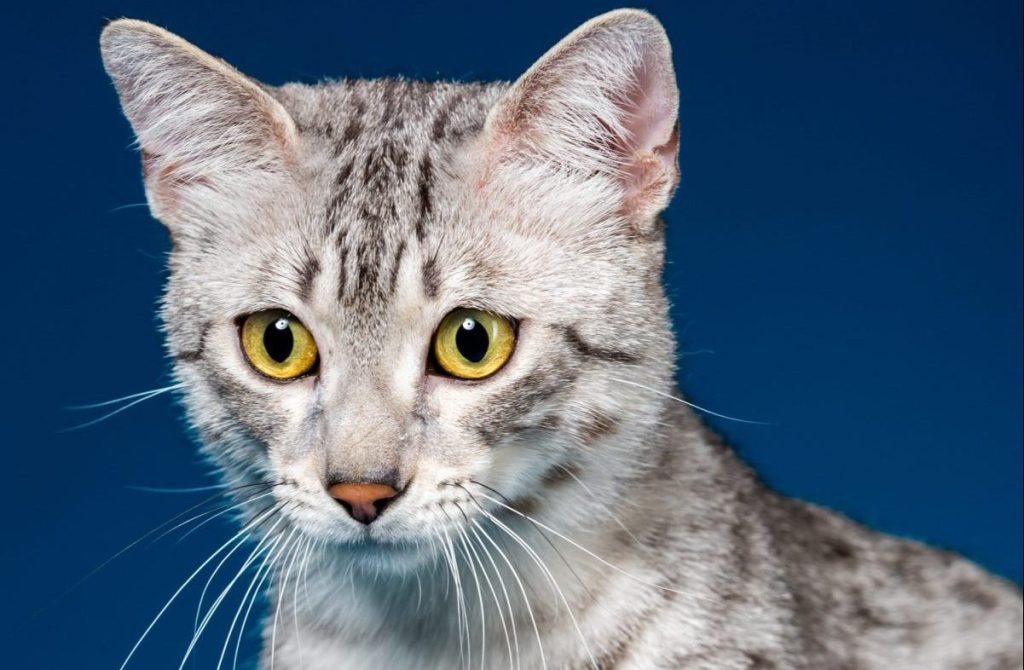The Egyptian Mau is a small-to-medium-sized ancient domestic cat breed known for their striking spotted coat, vivid green eyes, and lithe, athletic build. With their natural spots and unique skin flap aiding in agility, the Mau is one of the fastest domestic cats, capable of reaching speeds of up to 30 mph. The breed’s history traces back to ancient Egypt, where cats were revered as sacred symbols of grace and protection. Artistic depictions of similar spotted cats in Egyptian hieroglyphics and tombs highlight the breed’s deep historical roots, though its modern revival owes much to dedicated breeders in the 20th century.
Beyond their beauty, the Egyptian Mau is celebrated for their intelligence, affectionate nature, and playful temperament. These loyal and energetic cats bond closely with their families and enjoy interactive play but may be shy around strangers. While they are social and loving with their families, Egyptian Maus can be shy or reserved around strangers. They thrive in environments where they feel safe and comfortable, and they may take time to warm up to new people or situations. Despite their occasional aloofness, Maus are vocal and expressive, often communicating with a soft, melodic voice or unique chirps and trills.
When considering an Egyptian Mau, it’s advisable to prioritize adopting from rescue organizations or shelters to provide a loving home to a cat in need. However, if you decide to purchase, it’s crucial to choose a reputable breeder. Conduct thorough research to ensure that the breeder follows ethical practices and prioritizes the well-being of their cats. Reputable Egyptian Mau breeders prioritize the health and temperament of their cats, conduct necessary health screenings, and provide a nurturing environment for the kitties. This active approach ensures that you bring home a healthy and happy kitty while discouraging unethical breeding practices.
Quick Facts
- Origin: Egypt
- Size: Medium
- Breed Group: Natural
- Lifespan: 12-15 years
- Coat: Short and spotted, with a natural “M” marking on the forehead
- Temperament: Intelligent, playful, and affectionate
- Exercise Needs: Moderate to high
- Training: Relatively easy to train
- Grooming: Weekly brushing
- Health: Generally healthy, but can be prone to certain genetic health conditions, such as hypertrophic cardiomyopathy (HCM) and progressive retinal atrophy (PRA)
- The Egyptian Mau is the fastest domestic house cat, reaching up to 30 mph.
- The cats depicted in ancient papyrus paintings might be the predecessors to the Egyptian Mau.
- “Mau” means cat in Ancient Egyptian.
Egyptian Mau Pictures
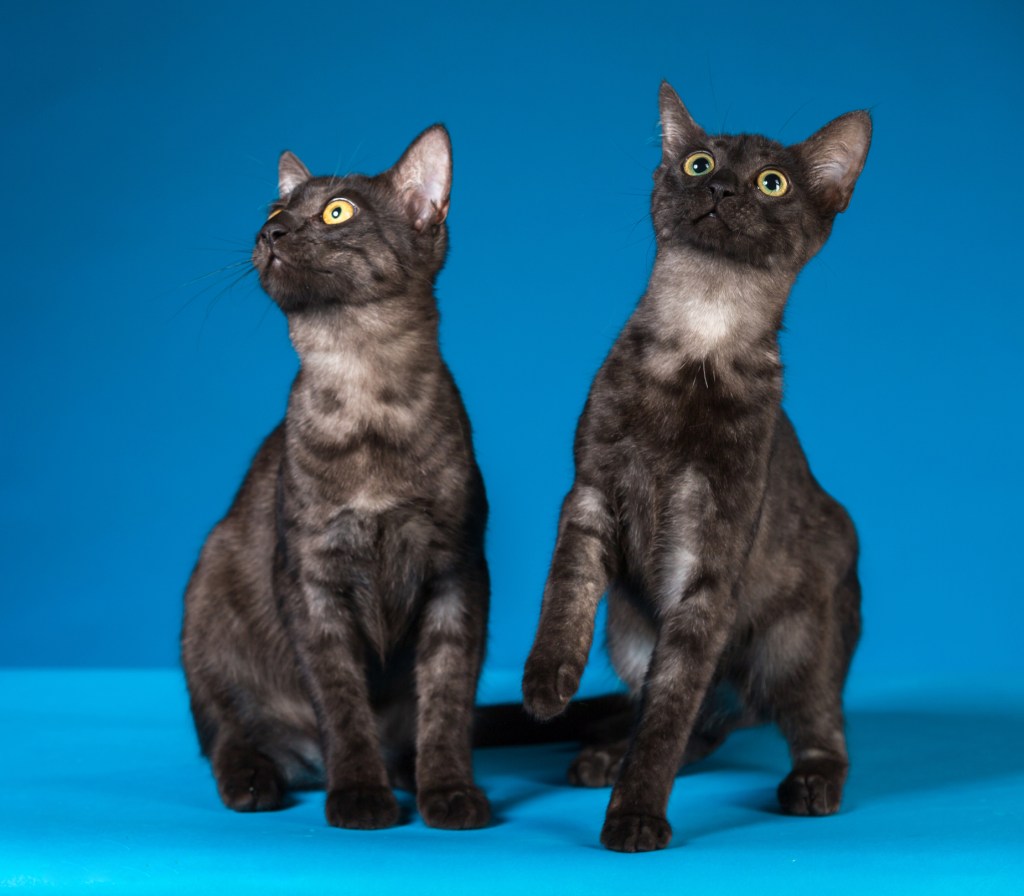
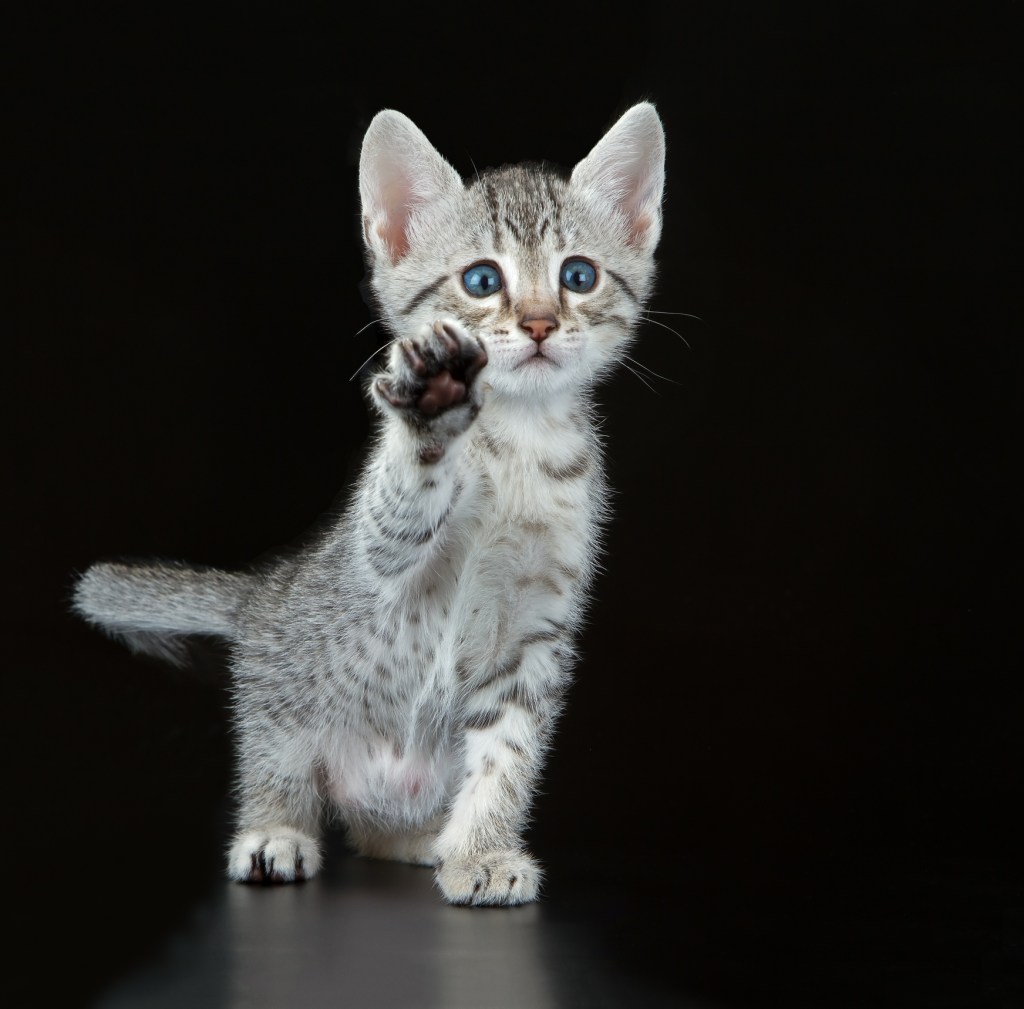

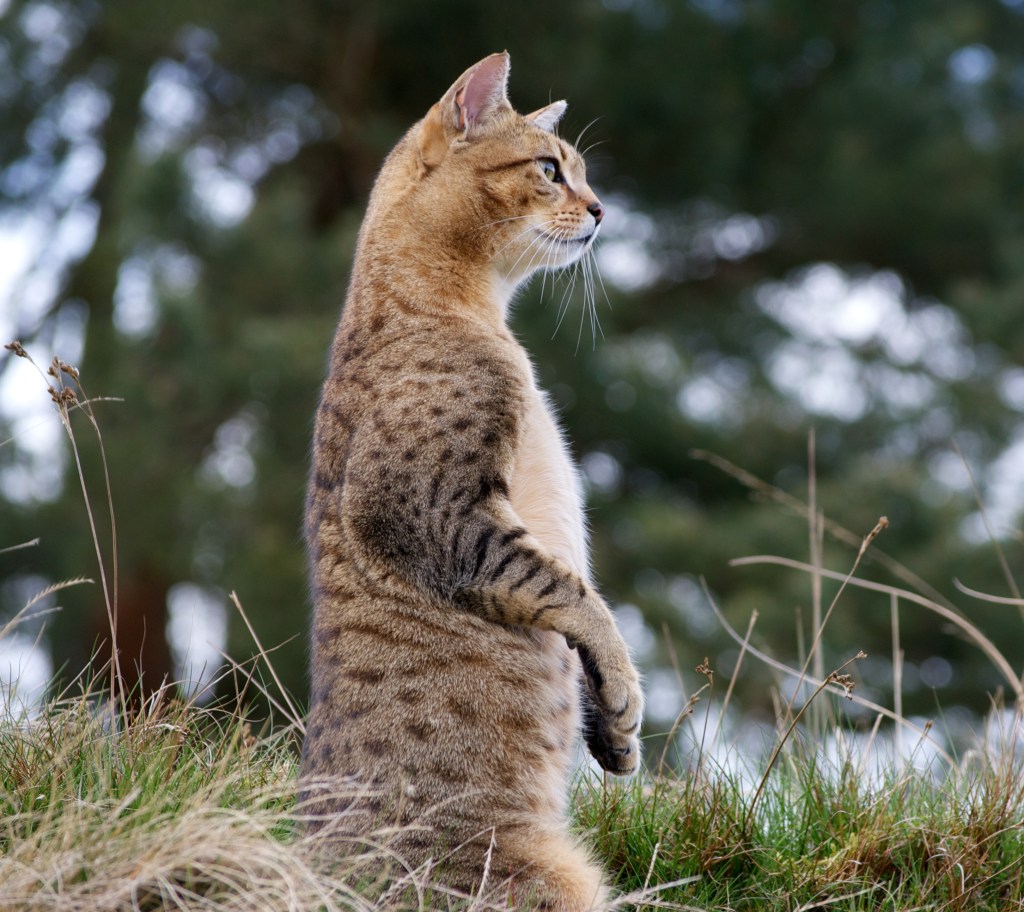
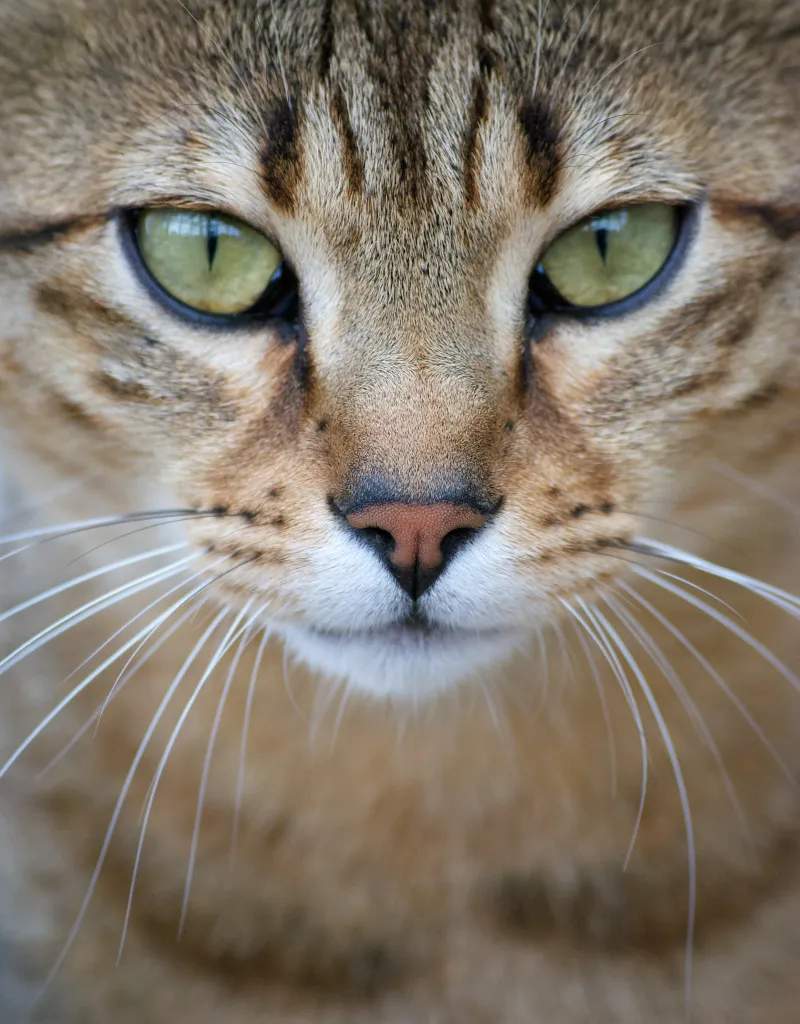
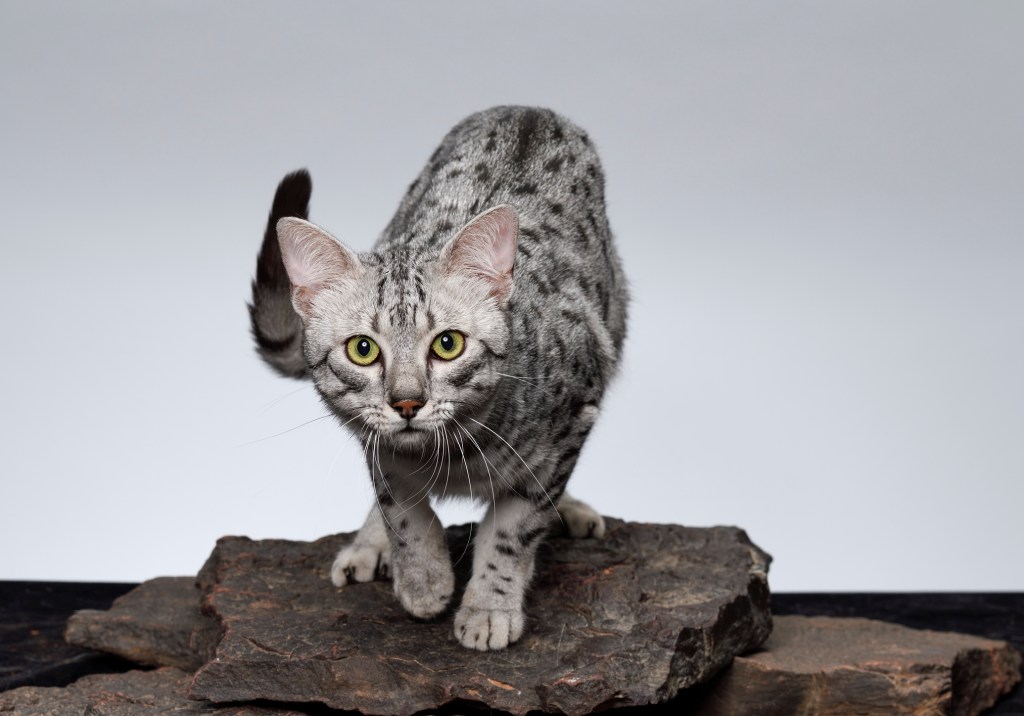
-
Affectionate with Family
Some cat breeds are typically independent and aloof, even if they’ve been raised by the same person since kittenhood; others bond closely to one person and are indifferent to everyone else; and some shower the whole family with affection. Breed isn’t the only factor that goes into affection levels; cats who were raised inside a home with people around feel more comfortable with humans and bond more easily.

See Cats Less Affectionate with Family -
Amount of Shedding
If you’re going to share your home with a cat, you’ll need to deal with some level of cat hair on your clothes and in your house. However, shedding does vary among the breeds. If you’re a neatnik, you’ll need to either pick a low-shedding breed or relax your standards. This furniture cover can make it easier to clean up cat hair and keep it off your sofa!
-
General Health
Due to poor breeding practices, some breeds are prone to certain genetic health problems. This doesn’t mean that every cat of that breed will develop those diseases; it just means that they’re at an increased risk. If you’re looking only for purebred cats or kittens, it’s a good idea to find out which genetic illnesses are common to the breed you’re interested in.
-
Potential for Playfulness
Some cats are perpetual kittens—full of energy and mischief—while others are more serious and sedate. Although a playful kitten sounds endearing, consider how many games of chase the mouse-toy you want to play each day, and whether you have kids or other animals who can stand in as playmates. A classic wand cat toy like this one is perfect for playful felines!
-
Tendency to Vocalize
Some breeds sound off more often than others with meows, yowls, and chattering. When choosing a breed, think about how the cat vocalizes and how often. If constant “conversation” drives you crazy, consider a kitty less likely to chat.
-
Kid-Friendly
Being tolerant of children, sturdy enough to handle the heavy-handed pets and hugs they can dish out, and having a nonchalant attitude toward running, screaming youngsters are all traits that make a kid-friendly cat. Our ratings are generalizations, and they’re not a guarantee of how any breed or individual cat will behave; cats from any breed can be good with children based on their past experiences and personality.
-
Friendly Toward Strangers
Stranger-friendly cats will greet guests with a curious glance or a playful approach; others are shy or indifferent, perhaps even hiding under furniture or skedaddling to another room. However, no matter what the breed, a cat who was exposed to lots of different types, ages, sizes, and shapes of people as a kitten will respond better to strangers as an adult.
-
Easy to Groom
Some breeds require very little in the way of grooming; others require regular brushing to stay clean and healthy. Consider whether you have the time and patience for a cat who needs daily brushing. You should definitely pick up this awesome de-shedding tool for cats of any hair length!
-
Intelligence
Some cat breeds are reputed to be smarter than others. But all cats, if deprived the mental stimulation they need, will make their own busy work. Interactive cat toys are a good way to give a cat a brain workout and keep them out of mischief. This scratcher cat toy can keep your smart kitty busy even when you’re not home!
-
Pet Friendly
Friendliness toward other household animals and friendliness toward humans are two completely different things. Some cats are more likely than others to be accepting of other pets in the home.
Egyptian Mau History
Whether the Mau is a product of thousands of years of Egyptian culture is a matter of debate, but if fanciers of the strikingly spotted cats wish to claim that they date to the times of the pharaohs, well, who knows? It could be true. The Egyptian Mau (mau being the Egyptian word for cat) is notable for being the only naturally spotted domesticated cat. In other words, the spotting pattern was not created by human manipulation of feline genes.
The cats were known in Europe before World War II, but the devastation of the war left the breed in a perilous state. The breed as it is known today dates to a silver female kitten given to Russian princess Natalie Troubetskoy when she was living in Rome. Depending on the story, the kitten was given to her by a young boy who had been keeping it in a shoebox or she acquired one from the Egyptian ambassador to Italy. Troubetskoy named the kitten Baba.
When she moved to the United States in 1956, Baba and two of her offspring came with her. Troubetskoy wanted to ensure that the Mau survived as a breed, so she wrote a breed standard and began breeding the cats under the cattery named Fatima. The breed was recognized in 1968 by the Cat Fanciers Federation, followed in 1977 by the Cat Fanciers’ Association. Importation of more Maus in the 1980s and again in 1991 increased the breed’s gene pool. Today the breed is recognized by most cat associations.
Egyptian Mau Size
The Mau is a medium-sized cat of 6 to 14 pounds
Egyptian Mau Personality
When the Egyptian Mau is happy, you know it. He vocalizes (called chortling) in a quiet, pleasant voice, swishes his tail rapidly, and kneads with his front paws. What makes him happy is being with his family, to whom he is fiercely devoted, or showing off his hunting prowess by chasing and retrieving a tossed toy or stalking and pouncing on a wriggling lure at the end of a fishing pole toy.
This is a moderately to highly active cat. He likes to jump and climb and will appreciate a tall cat tree, a window perch or two, and a sturdy scratching post that allows him to stretch out to full height.
The Mau also enjoys playing in the water. Don’t be surprised to find him dipping a paw into your koi pond or aquarium, turning on the tap in the bathroom or kitchen, or splashing water out of your pool — or his water dish.
The Egyptian Mau prefers family members to anyone else. When he’s not playing fetch, he enjoys sitting in a lap and being worshipped, just as his ancestors may have been. The Mau has the distinction of being the fastest domestic house cat, as she can run at speeds of up to 30 mph.
Egyptian Mau Health
Both pedigreed cats and mixed-breed cats have varying incidences of health problems that may be genetic. Egyptian Maus are generally healthy due to crossbreeding, but be sure to ask a breeder about the incidence of health problems in her lines and what testing has been done for any that are genetic.
Egyptian Mau Care
The Egyptian Mau’s coat is easily cared for with weekly combing to remove dead hair and distribute skin oils. A bath is rarely necessary. Brush the teeth to prevent periodontal disease. Daily dental hygiene is best, but weekly brushing is better than nothing. Trim the nails every couple of weeks. Wipe the corners of the eyes with a soft, damp cloth to remove any discharge. Use a separate area of the cloth for each eye so you don’t run the risk of spreading any infection.
Check the ears weekly. If they look dirty, wipe them out with a cotton ball or soft damp cloth moistened with a 50-50 mixture of cider vinegar and warm water. Avoid using cotton swabs, which can damage the interior of the ear.
Keep the litter box spotlessly clean. Cats are very particular about bathroom hygiene, and a dirty box may cause them to start using other places in the house instead. It’s a good idea to keep an Egyptian Mau as an indoor-only cat to protect him from diseases spread by other cats, attacks by dogs or coyotes, and the other dangers that face cats who go outdoors, such as being hit by a car. Keeping him indoors also protects local birds and wildlife from this avid hunter. Egyptian Maus who go outdoors also run the risk of being stolen by someone who would like to have such a beautiful cat without paying for it.
Egyptian Mau Coat Color And Grooming
The Mau’s most striking characteristic is his spotted coat in silver, bronze, or smoke (pale silver fur tipped in black), closely followed by his large gooseberry-green eyes. He is a medium-sized cat with a muscular body and a slightly rounded wedge-shaped head topped with medium-sized to large ears.
With hind legs slightly longer than the front legs, he gives the appearance of standing on tiptoe on his small, dainty feet. A medium-long tail is thick at the base, tapering slightly at the end. The medium-length coat has a silky, fine texture in the smoke coloration and a dense, resilient texture in the silver and bronze colors. The body is covered randomly with distinct spots that can be small or large, and round, oblong, or other shapes.
The forehead bears an M shape, the cheeks are adorned with “mascara” lines, and the tail is banded, ending with a dark tip. On the pale belly are dark spots that resemble “vest buttons.” In addition to the silver, bronze, and smoke colors, Maus can come in solid black, blue silver, blue spotted (a dilute version of bronze), blue smoke, and solid blue, but these colors are not permitted in the show ring. These cats of different colors make fine pets, however, sharing all the other characteristics of the Mau.
Children And Other Pets
The active and playful Mau is a perfect choice for families with children and cat-friendly dogs. He will play fetch as well as any retriever, learns tricks easily, and loves the attention he receives from children who treat him politely and with respect. He’s smart enough to get out of the way of toddlers but loves school-age children because they are a match for his energy level and curiosity.
Nothing scares him, certainly not dogs, and he will happily make friends with them if they don’t give him any trouble. He is a skilled hunter, however, and pet birds or other small animals are probably not safe in his presence. Always introduce any pets, even other cats, slowly and in a controlled setting.
Egyptian Mau Rescue Groups
More Info For You
If you’re also looking for a dog, check out DogTime’s dog breed page!
